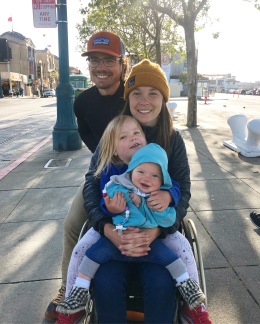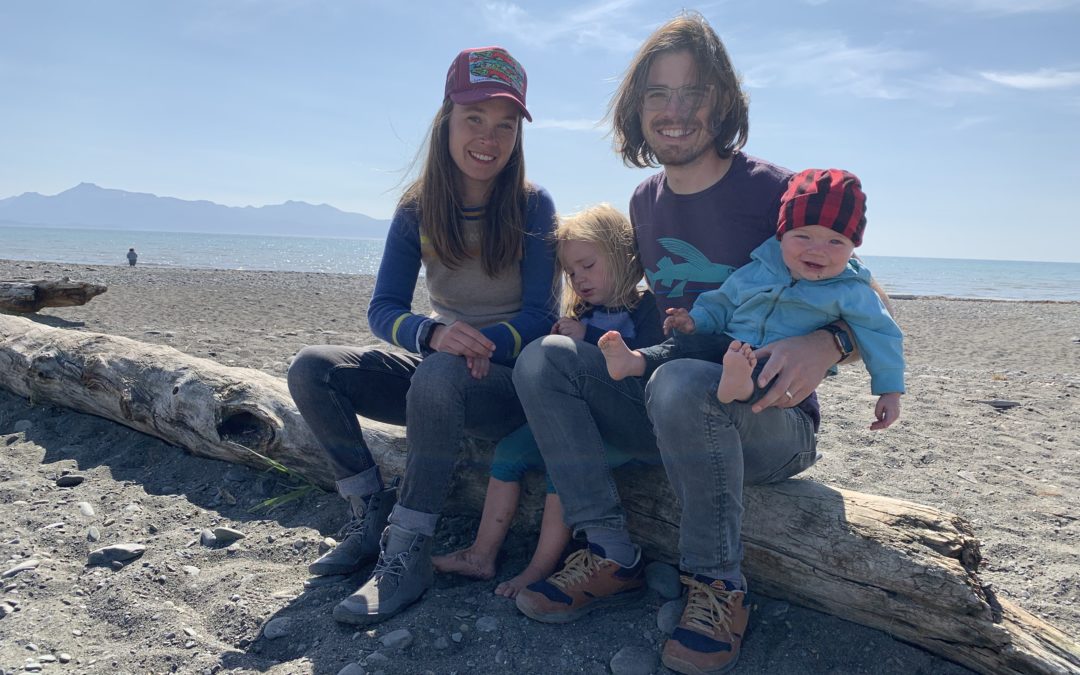by Alex Wegman
My Instagram inbox is full of messages from disabled people who are somewhere on the spectrum of awaiting or seeking parenthood, and they are terrified. They know it’s something they want, but have been told overtly and subtly that they’re not cut out for it. They’ve absorbed the narrative that disability precludes them from doing the things parents are supposed to do for their kids: playing catch, taking them down water slides, tossing them in the air, giving piggy back rides, you get the idea. Inability to walk or open a jar or tie a shoe translates to an inability to bond with and provide for a child. They scan my feed, full of pictures of my family — me in my wheelchair, a supportive husband, and two busy, smart kids — and feel hopeful, but their messages indicate that they still doubt they can have the same thing.
There’s a lot to unpack here. Society sends unfair messages to all kinds of parents. Didn’t make it to that PTA meeting? You failed. Didn’t throw a Pinterest-worthy first birthday party? You failed. Didn’t send your kid to the first day of school with a healthy enough lunch? You failed. Too much screen time? Failed. The unattainable expectations for parents create a culture of competition and inadequacy, and in light of that, disabled people are often left feeling like they don’t stand a chance. And on top of it all, disabled parents are stripped of their rights to their kids more often than nondisabled parents, as found in a 2012 report by the National Council on Disability.
I had some concerns about pregnancy and childbirth as they relate to my mobility, and like anything I’ve never tried before, I wondered how I’d manage certain tasks involved in taking care of a baby, but I had a leg up when it came to confidence in my ability to parent: My mom.
My own mother was born without her right arm from just above her elbow. Our disabilities are undeniably different, but they come with their own obstacles, and I grew up watching her take every single one of them in stride. As a mother, she was capable and confident managing a very physically needy oldest child and a spirited, stereotypically busy, sometimes difficult second child, and then she started all over with another baby when I was eight. She adapted all kinds of things, but the most memorable for me is how she’d sit me on the toilet lid backwards and braid my long, slippery, blonde hair with her left hand and her right foot, balancing like a flamingo and calling on me to hand her the hair tie when she was done. I loved my long hair, and though it’d have been easier for Mom if I’d kept it short, she never pushed me to cut it.
My thoughts on my mom as a role model aren’t about all the stuff she did “in spite” of her disability. They’re about how, even when her disability prevented her from easily doing something the average parent could’ve done, she was no less of a parent. She created a home where we were safe, advocated for our needs in school, celebrated our victories, counseled us in difficulty, and disciplined us when she needed to. It never crossed my mind that we were missing out on anything because she was missing an arm.
I don’t think my kids will feel like they missed out, either. Starting from the very first day of my daughter’s life, I’ve been adapting the standard methods of child rearing to fit inside the constraints of my physical limitations, and I imagine that’ll continue indefinitely.

When Arwen was a little baby, I carried her one of two ways: In my lap, with a pillow or rolled up blanket wedged under whichever end of her was at my knees—under her neck and head if she was on her back facing me, with her feet toward my belly, or under her knees and thighs if her shoulders and head were propped against me—or I wore her in a sling or soft structured carrier or wrap. The process of figuring out which carrier I’d be able to use was entirely based on trial and error, and it was frustrating and lonely. I’d do research, scouring the internet for pictures of people wearing my chosen contraption, find no evidence that people ever mothered sitting down, and end up feeling defeated, but also indignant.
Eventually, I’d take my chances and buy one, often to find that it wasn’t going to work for me. (For the record, a ring sling and an ergo have ended up being my go-tos, no matter how badly I wanted to love beautiful wraps and woven carriers.)
As Arwen grew, I had to come up with new ways to get her into the carriers. The heavier she got, the harder it became for me to load and unload her the way all the online video tutorials said I had to. For weeks, I tried to comply with manufacturer’s recommendations, feeling the pressure of the warnings that I’d surely drop and kill my baby if I didn’t.
Then it dawned on me: Those tutorials were not made for me. Those guidelines and recommendations were set for people with typically functioning hands and strong arms, and who would be standing while they performed tasks in ways that were becoming impossible for me. The absence of representation can feel like disqualification. A glaring, cold message: “Turn back. This isn’t for you. You don’t belong here.” So I was going to have to blaze my own trail and not worry about judgement. I had to shake off fears and guilt that were based on a system that was telling me that its way was the only good way, the only safe way.
So I did. I started experimenting with the sling, sitting in front of the mirror in my bedroom so I could see what the fabric was doing as I tugged and lifted it, situating Arwen comfortably and securely. If something felt precarious, I changed course. After a few 15 or 20 minute sessions, I had devised and mastered two new ways to get Arwen into and out of the sling. Then I did the same thing with the ergo. Bam. Two new ways to get her into and out of that, too. Guess how many times I dropped her in the process. None. Guess how many times I’ve dropped her or her little brother since. Right. None. Because I listened to my instincts and went my own way. This pattern of searching for examples or ideas or resources and then eventually putting my own creativity to work has repeated itself in everything from getting kids into and out of the car to preparing meals while the baby wants to be held.

The parenting world is not used to people like me, but do you know who is used to people like me? My kids. Arwen approached her dad with a very serious query awhile back: “Mama have a wheelchair. Why you not have a wheelchair like Mama, Daddy?” She had never asked me why I did have a wheelchair — that was her normal because I was her primary caregiver. She was used to having a lap to sit in at all times, a portable jungle gym always at her disposal, and she wanted to know why Daddy was missing such an important characteristic. I’m not naive; I know her sense of normal will change as she spends more time at friends’ houses and at school. It already has, and we tackle questions about how our life is different from average with openness and encourage her curiosity, and approach disability and other differences simply as variations of normal.
Almost four years into motherhood, I don’t feel even remotely like I’m lacking any of the skills necessary to be a really good mom. I’ll never give my kids shoulder rides or take them to the beach without a helper, but I’m well equipped to love them and give them a full, rich childhood — and in seasons when I need help with some of the physical stuff, I call on my community. There are lots of things that can make a person a person unable to parent. Disability doesn’t have to be one of them.
Alex Wegman is a mother of two, writer, private tech consultant, frequent traveler, outdoorswoman, and full time wheelchair user. She writes about her experiences as a disabled person and parent, always with the goal helping to connect the disability community and increasing its visibility in mainstream culture. She regularly authors short essays, which she shares on instagram at @alexwegman.
She lives in the Santa Cruz Mountains in California with her one and three year old kids, husband, and Labrador.
Alex can be contacted at alexwegman@icloud.com.
Did you like this article? Are there other topics you’d like to see us publish on? Do you want to apply to be a guest blogger? Please take our quick, 3-question survey and let us know what you think! BLOG SURVEY LINK: Take Survey


